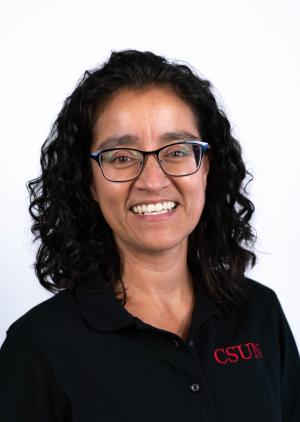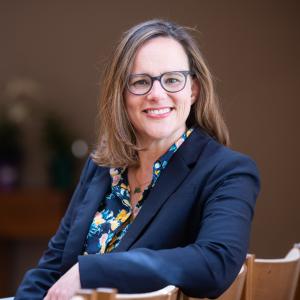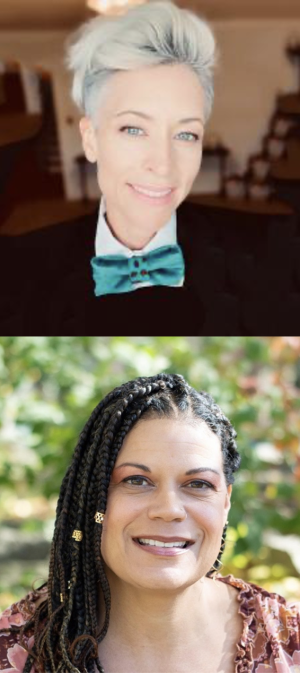Resources
Interview with Carolyn Medine
Interview with Katherine Turpin.

I was asked for pictures of me while teaching in the classroom. An organization I’m part of wanted them for one of their platforms and I obliged. I asked a student to use their phone to take pictures of me during one of our class sessions. I asked them to do it discreetly so the pictures could be as candid as possible. And boy were they candid—and revealing! I was rolling laughing as I saw myself in all kinds of animated postures: down on one knee, face looking upward, arms outstretched toward the sky; all manner of facial expressions and creative hand gestures; nutty drawings of giant circles and spirals on the chalkboard as I tried to explain who-knows-what concept. It was a surprise to me that my teaching style was so animated and a bit dramatic. And while it amused me to see this about myself, it did not make me self-conscious, for even though I had not realized this about myself, my students surely had known me this way the whole time. I got to see what my teaching looked like a little better and know that while there is no single way to teach, I surely had mine. The larger point, of course, is that there is no blueprint to how we embody our teaching, and the more we understand this and understand ourselves, the better we can move into our own. I had received an earlier lesson on embodiment the very first time I presented a paper at the annual meeting of the American Academy of Religion (AAR). I hated every minute of my first paper presentation: I hated the podium—how much it blocked my sense of connection with the listeners and made me feel like I could not see everyone clearly. I hated the microphone because it meant I couldn’t move about and I had to stand on my tiptoes to try and keep it at the right level. I hated reading the paper because it meant I was the only one speaking that whole time. It was a stressful and miserable experience. The following year, then, when I was to take part in a commemorative panel scheduled in one of the very large presentation rooms at AAR, I knew I had to find a way to change my experience of presenting. Through a friend, I received acting coach tips to help me feel more comfortable and confident about presenting. The advice in a nutshell was to experiment and play with the embodiment of the activity: practice being at the podium, around it, in front of it; explore ways to change my spatial relationship with the listeners, the paper, the microphone. Play with time, pauses, moments of possible interactions with the listeners, even if not explicitly verbal. She told me to listen to what my body was telling me through its discomfort—what exactly was not working? —and to explore ways to address and attend to the cause of the experience. I should accept that presenting in the traditional way did not work for me and explore and play with various adjustments and shifts to discover the approach that did work for me. Effectively, she released me from the idea that there was a single blueprint for conference paper presentations and encouraged me to bring myself, mind and body, to discover my own. In my last post I wrote that “we teach humans, not subjects,” and argued that in our teaching it is important to attend to the humans before us first and foremost. It is likewise important to attend to ourselves, to who we are in the wholeness of our mind and body, and to allow ourselves to feel and sink into the embodiment of the teaching relationship. Teaching is relational as much as it is embodied. And it takes some experimenting to find one’s grounding within them both. But before receiving the tips from the acting coach, I received an invaluable tip from a student that has remained with me since my first week as a professor. The Faculty Development team at my university invited students to join the new faculty for lunch and an informal Q & A during the new faculty orientation event. I asked the student sitting at my table, “If you could give one piece of advice to new faculty, what would that be?” He said, “Let us see you as human, sometimes. Be ok showing us your ‘non-professor human side’; it helps us relate to you better.” I always remember that tip—it reminds me that it is okay to bring my peculiar, embodied self to the relational activity of teaching and to give myself permission to sink into it, even with its flair and dramatic gestures. What’s yours?
Interview with Evelyn Parker

It was a spectacular morning on Emory’s verdant quad. The early October air was just offering the hint of crispness that announced the imminent arrival of fall. The grass, roped off for re-seeding (a detail some students thought revealed loving care for the soil and others thought revealed a desire to control a manicured landscape), shimmered a dewy electric green. The oak trees’ leaves were beginning to flaunt their autumn gold, offset by an expanse of sky the color of a robin’s egg. But then, I noticed two students were standing off to the side of the rest of the class, whispering to each other, smiling, and almost giggling. All my self-preservation alarm bells hard-earned in junior high started going off. What are they laughing at? Is it me? Am I doing or saying something stupid? It was the “Religious Education and Our Ecological Context” class, and we’d come out to the quad on an October morning to discuss and try to practice Sallie McFague’s use (which she borrows from Marilyn Frye) of the concepts of the “loving eye” and the “arrogant eye” when encountering nature.[1] When beholding nature with an arrogant eye, we look upon it as an object, something separate from ourselves for our use and convenience. When beholding nature with a loving eye, we acknowledge its mystery and relationship to us, appreciating it on its own terms. The students were divided into two groups, each of which assumed the point of view of the arrogant eye or the loving eye and asked to make notes of what they saw or encountered in the quad from that point of view. Some students bounded off in pairs or trios, chatting and pointing out what they saw to their classmates, while others slowly wandered off quietly by themselves, pens and notebooks in hand. A couple of students lingered near me, asking a question about an upcoming assignment, perhaps not entirely comfortable with this task of just being in their bodies outdoors. I often incorporate such embodied and contemplative learning experiences, particularly in this class. In fact, the students also were asked to choose a location, near where they live, to observe for five minutes daily. They were invited to marshal all their senses to make note of all the changes in that place as the semester slid from late summer into fall, and then winter. A few weeks earlier, we visited an art installation by Charmaine Minniefield at Emory’s Carlos Museum, Indigo Prayers: A Creation Story. In that work, Minniefield powerfully uses pigments indigenous to Gambia, where her ancestral roots are found, to visually represent the “ring shout,” a dance of prayer and resistance. In these seven very large paintings, installed in such a way that they move slightly as one walks past, the artist’s own body is represented. The paintings tell an embodied story of the relationship between the self and place (and displacement), mirroring a theme for our class. All of this is to say that in this class, which considers the spiritual and moral relationship of the self (and the community) to particular places and to the “more-than-human world,”[2] I have intentionally built in embodied pedagogies to open up paths of knowing perhaps not available in more didactic or even discursive classroom activities. I made this decision on sure theoretical and pedagogical footing: Donna Haraway and Lorraine Code both argue for a more expanded epistemological framework, appreciating the role that embodied and emotional experience play in the production of knowledge.[3] And yet, as we were gathering back to talk about the experience, I was distracted by the two students standing very near me who seemed to be having a laugh at my expense. I immediately began to second guess my choice to bring the class outdoors. My inner voice began shouting at me: “This is graduate school for God’s sake! Get serious!” (I suspect that my inner voice comes from the same place as Stephanie Crumpton’s, also featured in this blog series: “Even worse, I hear my own voice telling me, ‘You’re dumbing it and yourself down. Folks [including yourself] need to step it up.’”) I didn’t want to put the students on the spot, but they made eye contact with me as I opened up the discussion. I paused, and one of them said, “We were just saying how much we like it that you take us on ‘field trips.’” They were happy. Now, I can’t say that knowing this fact erased my self-doubt. Indeed, there’s some small part of me that still believes seriousness and joy are somehow in tension with each other, and learning should be serious. As the conversation unfolded, however, a tapestry was woven that incorporated all the students had beheld on the quad, and the ways in which McFague’s categories accounted for (or didn’t) the ways in which we were relating to the more-than-human world in this moment. I revealed more of my pedagogical rationale for being out there, the principle of embodied learning as a pathway to ecological knowing, though we’d discussed that principle before in the ordinary classroom. As we walked back to the building, the students were animated, talking about the ways in which they might incorporate similar practices in their field sites or other settings. And we were happy. [1] Sallie McFague, Super, Natural Christians: How We Should Love Nature (Minneapolis, MN: Augsburg Fortress, 1997). [2] Abram uses this phrase to appreciate the animacy of the natural world, and to avoid objectifying dualism. David Abram, The Spell of the Sensuous: Perception and Language in a More-Than-Human-World (New York, NY: Pantheon Books, 1996). [3] Donna Haraway, “Situated Knowledges: The Science Question in Feminism and the Privilege of Partial Perspective,” Feminist Studies 14, no. 3 (1988): 575–599; Lorraine Code, Ecological Thinking: The Politics of Epistemic Location (New York, NY: Oxford University Press, 2006).
To whom are you obligated when you complete your degree? If education is for the public good – then what does it mean that public education promotes and forms individualism? What is the purpose and aim of public education, of higher education? What if the policing of teaching is detrimental to the thriving of a democratic republic? What would it mean to promote communal values in classrooms bound to shaping individualistic mindsets?

Your PowerPoint slides are not projecting on the screen as students trickle into the classroom. Normally you like to have everything prepared before their arrival, but ITS is not responding to your calls. Running on coffee and a few hours of sleep you begin the lecture only to be interrupted by late students. Pushing your hospitalized parent out of your mind, you continue with the lecture thinking that you never would have disrespected your professors this way. A student in the front row is nodding off to sleep. You made it to class early after dropping kids who were screaming for your attention, with runny noses, off at daycare. An “A” student catches your eye. They are diligently taking notes despite having pulled an all-nighter. It is a scene all too familiar to educators. We check our bodies and emotions at the door and wonder why students don’t also. Our advisors and mentors taught us to be disciplined. Prioritize your research and writing in order to succeed. The life of the mind is built upon outsourcing the mundane things like cooking and cleaning to someone else. Students who prioritize learning information to the neglect of their health are rewarded within the status quo. When they compartmentalize their learning from the messiness of life, it is a relief to the educator. They focus on ideas rather than responsibilities to community. Conversely, students overcome by malnutrition, lack of resources, and abuse are punished. They face negative consequences for prioritizing caregiving over self-care. The message is clear: students who are overcome by contexts beyond their control or extenuating conditions are left to “figure it out” as an acceptable pedagogical tool of disciplined thinking. We as educators often assume that the process of learning is for the students, and our job is to deliver content. We use words like “rigor” and “grit” to put the onus on students to persevere through the stresses of learning. Those who don’t succeed presumably were not worthy. But what if we as educators are the problem? Unhealed trauma certainly inhibits student learning, but, perhaps more to the point, the unhealed trauma of educators perpetuates harm in the classroom. What might trauma-informed pedagogy look like? Stacy Williams explains that trauma is not defined by events, but by the lingering effects on our brains and bodies. People can experience the same event and some seem to emerge unscathed, while others may be left struggling to return to their daily routine. This explains the differing levels of impact upon communities with shared experiences and divergent effects. Rather than adjudicate whether the student’s distress is reasonable (the loss of a pet, end of a romance, hunger, discrimination, etc.), we would do better to model teaching and learning as embodied and contextual. We (the authors) suggest that as educators, one of the best things that we can do to improve pedagogy is to attend to our own bodies and emotions. With this baseline in mind. we can begin to unpack the experience of the professor described above. Perhaps the late student was also visiting a loved one in the hospital, the sleeping student might have also been up most of the night with a sick toddler, and many students have missed breakfast. Paying attention to our own needs influences how we hold the learning space. Stress and trauma disrupt the students’ ability to learn, but they also disrupt educators’ ability to teach. The lingering effects of stress and trauma show up in the brain and body faster than logic and reason can process and remain in the body systems much longer than people realize. Which professors and mentors reminded you to attend to your wounds? If they didn’t, what are the lingering effects? In order to avoid retraumatizing others, initiate self-awareness and get curious about the behaviors of your students. Here are a few questions we propose to get you started: When did I last eat a nutritious meal and drink a full glass of water? Do I need to go outside for some movement? Who have I deeply connected with this week? In short: what do you need today to be the best version of yourself to show up for others? Attentiveness to your bodily and emotional needs sets the tone for trauma-informed teaching and learning.
Interview with Stephanie Crumpton
Interview with Roger Nam